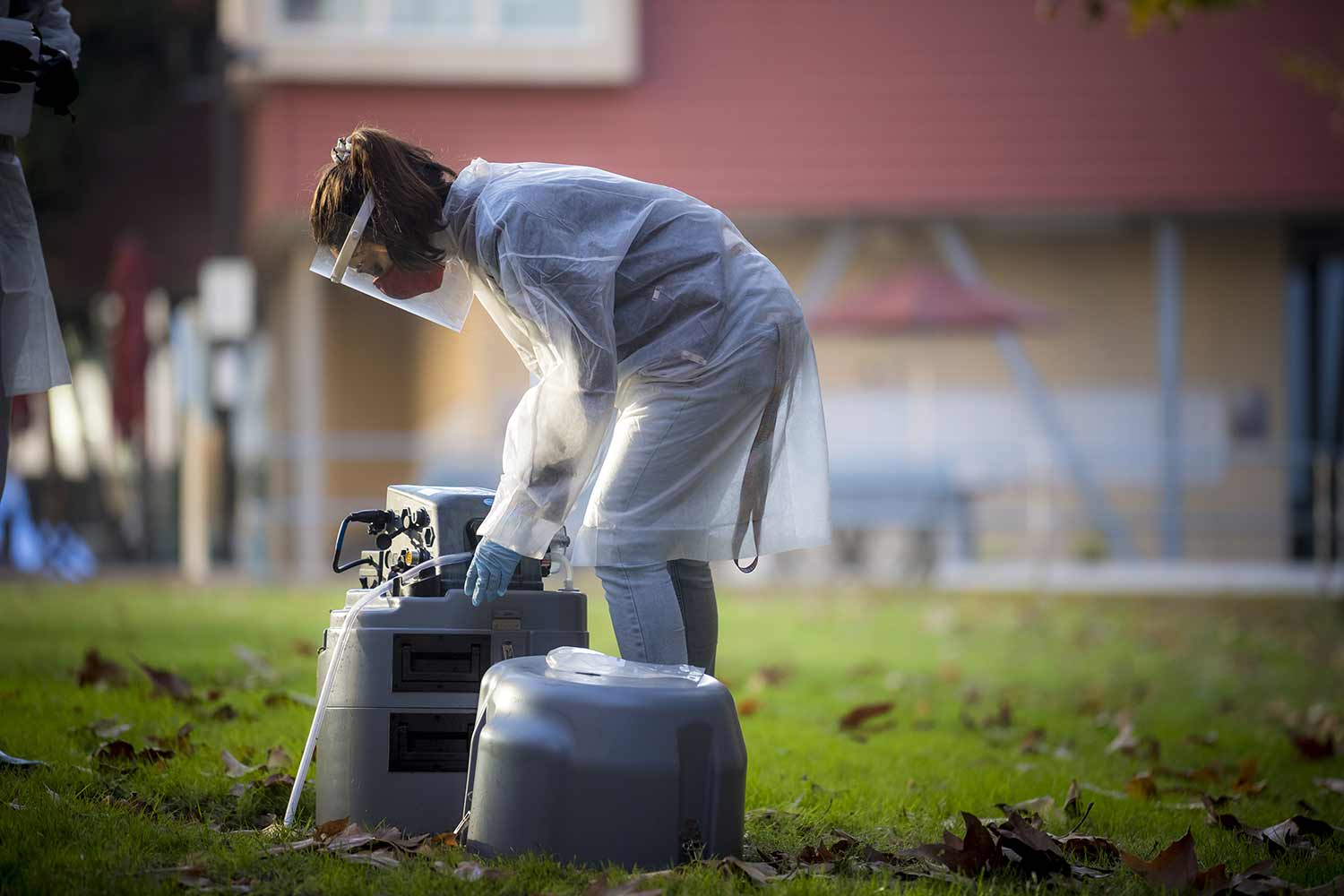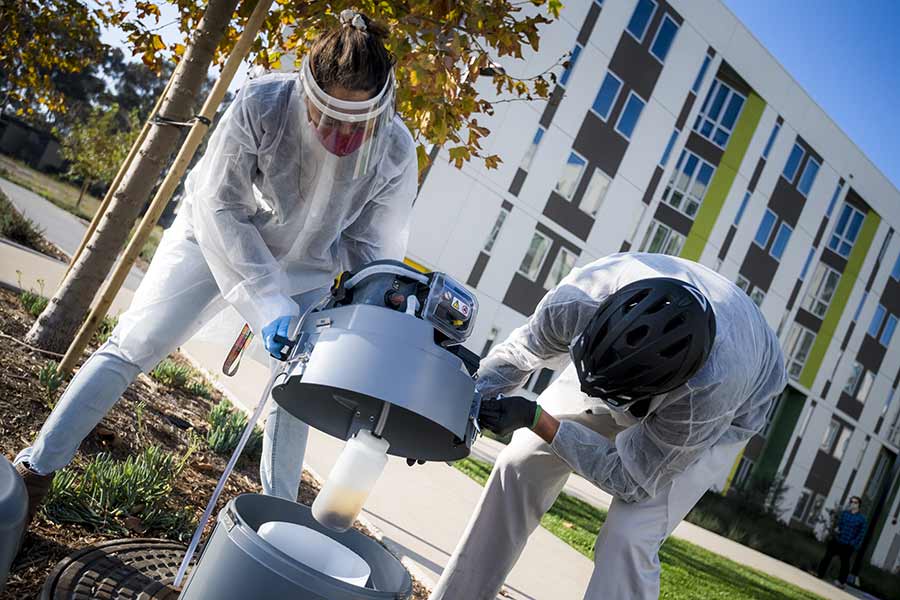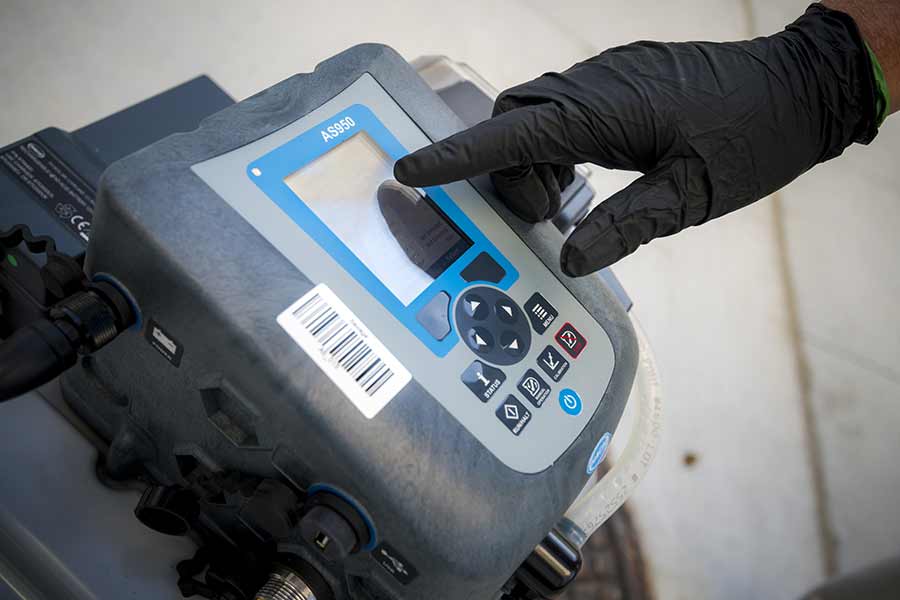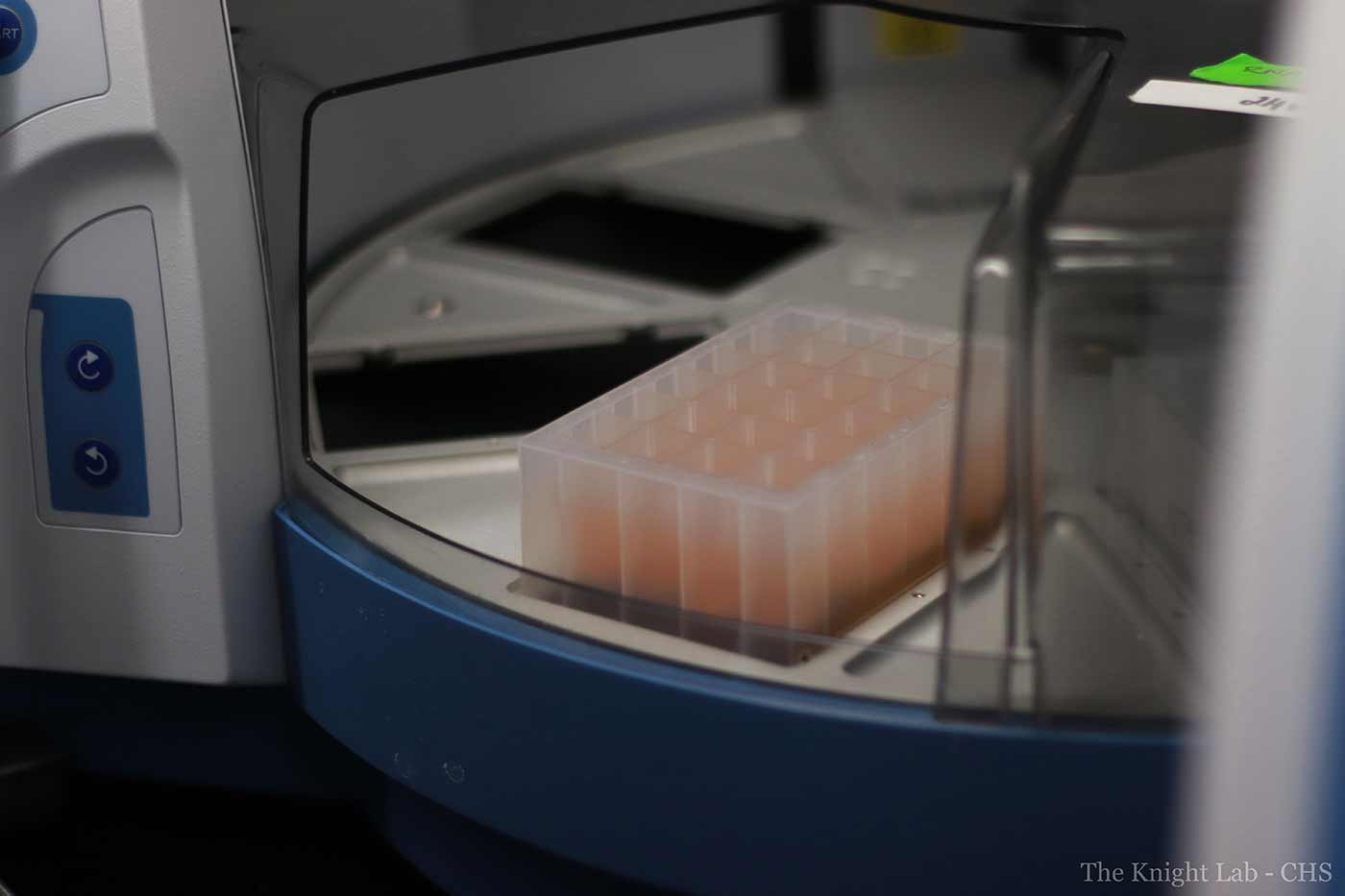By:
- Heather Buschman
Published Date
By:
- Heather Buschman
Share This:

Smruthi Karthikeyan picks up wastewater samples from collection robots on the UC San Diego campus. Photo credit: Erik Jepsen/UC San Diego.
The Proof is in the Poop
When early evidence emerged that people with COVID-19—whether or not they have symptoms—shed the virus in their stool, “the sewer seemed like the ‘happening’ place to look for it,” said Smruthi Karthikeyan, an environmental engineer and postdoctoral researcher who works in the lab of Rob Knight at UC San Diego School of Medicine.
Researchers in Knight’s lab are used to getting their hands dirty. The team has long been known for their studies of the gut microbiome—the unique communities of microbes that live in our gastrointestinal tracts. People all over the world participate in their research program, The Microsetta Initiative (aptly abbreviated “TMI”), by mailing their fecal swabs to Knight’s lab. The crowdsourced project has allowed the team to study the many factors that might influence the makeup of a person’s gut microbiome, and the many ways it influences our health.

Smruthi Karthikeyan (left) and Rob Knight (right) pick up wastewater samples from collection robots on the UC San Diego campus.
By the summer of 2020, Karthikeyan, Knight and team were sifting through fecal samples closer to home —sewage flushed away by people occupying UC San Diego buildings—to look for the virus that causes COVID-19.
Just one month after their wastewater detection system came online, the team detected a positive case in the Revelle College area on the Friday afternoon before the Labor Day weekend.
“At the time, we had just three wastewater samplers around campus, two by the hospital, which of course will be positive due to the patients being treated there, and one negative control by Revelle College,” Karthikeyan said. “It was business as usual and I packed up to leave the lab for the day when I saw that the Revelle sample was actually positive! I re-ran it multiple times for sanity—all came back positive. That launched a thousand ships and put the whole surveillance team on overdrive.”
The campus community was notified within 14 hours and targeted messages were sent to people associated with the affected buildings, recommending they be tested for the virus as soon as possible. More than 650 people were tested for COVID-19 that weekend. As a result, two asymptomatic individuals were diagnosed with COVID-19, and they self-isolated before an outbreak could occur.
Now, Knight, Karthikeyan and team monitor wastewater from 350 UC San Diego buildings daily. Notifications are automatically sent to affected buildings, results are available on a public dashboard and positive samples are being sequenced to track the emergence of new coronavirus variants.
While wastewater monitoring has become mostly routine, there are still surprises. While Karthikeyan and team were collecting wastewater near the Coast Apartments one day, they found a gopher had dug through and buried their sampler. To make matters worse, while they were busy investigating that situation, their golf car rolled off the path and got stuck. They had to get help to physically lift the cart back onto the path.
After months of optimizing the process, the team can detect even a single infected, asymptomatic person living or working in a large building of more than 500 people. They found that notifying the occupants of each building with positive wastewater increases COVID-19 testing rates by as much as 13-fold. The approach has enabled early detection of 85 percent of COVID-19 cases on the campus, the researchers say.
Wastewater screening is an integral part of UC San Diego’s Return to Learn program, the evidence-based approach that has allowed the university to offer on-campus housing and in-person classes and research opportunities throughout most of the pandemic. Return to Learn relies on three pillars: risk mitigation, viral detection and intervention. With approximately 10,000 students on campus during the 2020-2021 academic year, the program kept COVID-19 case rates much lower than the surrounding community and compared to most college campuses, maintaining a positivity rate of less than 1 percent during that time.

At each collection point, a robot takes a sample of the wastewater flushed from nearby buildings every 10-15 minutes. Bottles of sewage are collected from the robots every morning, and they contain a representative sampling from the entire previous day.
“Our wastewater screening program demonstrates how the many different parts of UC San Diego can work together as a system to keep campus safe,” said Knight, who is professor of pediatrics and director of the Center for Microbiome Innovation. “This work required not just advances in viral sample processing, but teams including Logistics, Environmental Health and Safety, campus and health system IT, Facilities Management, and many others, as well as leadership from the Return to Learn program to make it happen.”
Knight’s team also helps manage the Expedited COVID IdenTification Environment, or EXCITE lab, which runs clinical diagnostic tests for the UC San Diego community as part of the Return to Learn program, as well as for many research projects. The researchers are also partnering with local K-12 school districts to provide clinical testing through EXCITE and wastewater screening with Knight’s lab, and working with other universities and organizations to replicate these successes. Knight says the approach has the potential to expand to many other stool-borne pathogens in addition to COVID-19, such as the flu.
Here’s how UC San Diego’s COVID-19 wastewater screening process works:
- More than 130 robots around campus slowly collect sewage flushed from 350 buildings through a tube and into a collection bottle, providing a representative sample over a 24-hour period.
- Every morning, seven days a week, a team of students and staff in matching T-shirts deploys across campus on golf carts to collect the sewage bottles waiting for them at each collection point and deliver them to Knight’s lab at UC San Diego School of Medicine.
- In the lab, the team adds magnetic nanoparticles designed to bind any viruses in the sewage.
- A robotic platform concentrates the viral samples and extracts viral RNA—the genetic material that makes up the genome of some viruses, including the COVID-19 virus.

- Viral RNA is transferred to another robotic machine that mixes it with the reagents needed to run polymerase chain reaction (PCR). Among these are primers, bits of genetic material that specifically bind the COVID-19 virus’ signature genes.
- The samples are moved to a thermal cycler, a machine that performs PCR. The machine cycles back and forth between heating and cooling, which helps the primers make many copies of the COVID-19 virus signature genes, if they are present in the mixed RNA sample.
- If detected by PCR, COVID-positive samples trigger automated email notifications to the campus community, prompting individuals who used the restroom in the affected buildings at a given time to get tested, and isolate if diagnosed with COVID-19.
- Data is added daily to a publicly available digital dashboard at returntolearn.ucsd.edu/dashboard.
Share This:
You May Also Like
Stay in the Know
Keep up with all the latest from UC San Diego. Subscribe to the newsletter today.



